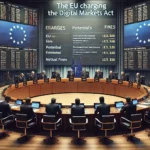As technological competition between the US and China heats up, the European Union (EU) must be more assertive in its technology agenda to maximize its global influence. Critical and emerging technologies are vital to the EU’s security and economy, especially regarding the green and digital transitions. However, the deepening “tech war” between the US and China has made these technologies geopolitically contested, with risks of being used irresponsibly and anti-democratically. The new European Parliament faces tough decisions about its technology agenda, focusing on becoming a technology leader to safeguard against these risks, ensure security, and boost industry prosperity.
Strategic Policy Goals for the EU
To achieve this, the EU should focus on three main strategic policy goals:
- Driving Innovation: Ensuring control and access to cutting-edge technology.
- Regulatory Power: Ensuring the safe, responsible, and accountable use of technology both in the EU and globally.
- Protecting Industries: Safeguarding industries reliant on technology from supply chain disruptions and the weaponization of dependencies.
Each goal comes with its trade-offs. For instance, a light regulatory approach may foster innovation but could fail to protect people’s rights, while too much regulation might stifle innovation and push firms to move elsewhere. Similarly, prioritizing economic security can enhance strategic autonomy but might slow down growth and limit technological leadership.
Balancing Innovation and Protection
The EU has some catching up to do in driving technological innovation. Europe has only 7 frontier AI models compared to China’s 20 and the US’s 109. In semiconductors, the EU relies on Asia for 75-90% of its supply. The EU’s top seven tech firms are 20 times smaller than their US counterparts in total stock value.
Critics argue that the EU’s focus on promoting innovation and ensuring responsible technology use creates a restrictive environment. However, Europe’s technological lag predates technology-based regulation and is more due to structural issues like market fragmentation and diverse governmental decisions on education, immigration, intellectual property, taxes, and antitrust laws. Therefore, a more holistic strategy is necessary.
Protecting Technology-Dependent Industries
Trade-offs also exist between driving innovation and protecting industries dependent on technology. While importing cheap critical technologies can promote growth, it increases dependency and vulnerability to disruptions. The EU has chosen to protect its industries by investing in critical technologies and building long-term resilience, exemplified by the European Chips Act, which aims to protect the semiconductor industry through public and private investments.
Building a Resilient Technological Industry
Policymakers have various tools to balance these trade-offs and boost the technology sector, including:
- Funding Research and Innovation: Investing in new technologies.
- Subsidizing Technological Industries: Providing financial support to tech firms.
- Enhancing the Internal Market: Making it more competitive and attractive to firms and investors.
- Launching Visa Programs: Attracting technical talent.
- Adopting EU-Wide Regulations: Prioritizing responsible technologies.
Achieving Global Influence
Even with a resilient technological industry, the EU needs a strategy to achieve global influence and prevent other actors from limiting its options. The EU has advanced its values in global tech governance through the “Brussels effect,” where its consumer power and internal market force companies to adopt its standards. This was evident with the General Data Protection Regulation (GDPR).
However, as technology becomes more geopolitically contested, countries are likely to set their own standards. For example, different AI regulation approaches have emerged in the EU, US, and UK, providing alternative choices for other countries.
Cooperation and Independence
The EU is working with like-minded allies in forums like the G7, OECD, and the EU-US Trade and Technology Council to ensure safe technology use and protect technology-related industries. However, aligning with the US in critical technologies involves tensions. The EU’s decision to halt high-tech semiconductor exports to China, influenced by US pressure, highlights its vulnerability to Washington’s demands. Therefore, the EU must de-risk its critical technologies from US actions, such as by developing its own intellectual property rights in the semiconductor value chain.
Conclusion
The EU must become more proactive to be an assertive global actor. This requires building technological power and using it to gain global influence. Policymakers must navigate complex trade-offs and geopolitical tensions, with Europe’s economic growth and security at stake. It is up to the new parliament to take effective action.
















